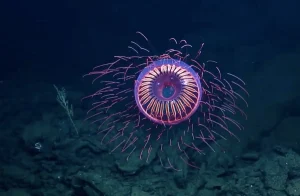Who Lives in Eternal Darkness
The ocean is one of the most mysterious places on Earth, and the deeper its waters, the more mysterious its inhabitants. Deep-sea zones, located below 200 meters, are immersed in eternal darkness, where sunlight does not reach the bottom. Here, the temperature is close to zero, the pressure is enormous, and the living conditions are extreme. However, even in this seemingly lifeless world, amazing fauna, adapted to the harshest conditions, thrives.
The depths of the ocean are home to organisms that seem more like creatures from science fiction than real animals. Here you can meet the famous angler fish, which uses a glowing “flashlight” on its head to lure prey into pitch darkness. This bioluminescent organ is the result of symbiosis with bacteria that produce light. Such adaptations allow deep-sea inhabitants to find food and communicate in complete darkness.
Another inhabitant of the deep is the giant squid, which can grow to over 10 meters in length. This mollusk has long been the subject of myths and legends among sailors, until it was filmed in its natural habitat. Giant squids lead a secretive lifestyle and engage in battles with the even more mysterious sperm whale, their main enemy. These battles take place in the dark, where vision is almost useless, and everything depends on sensations and instincts.
Deep-sea fish, such as the bagfish or deep-sea flounder, have unusual body shapes, simplified bone structure, and enlarged eyes or, conversely, completely blind. Their bodies are often covered with sensitive organs that can detect the slightest vibrations in the water. In conditions where prey is rare, such adaptations allow them to seize the chance to survive.
Deep-sea ecosystems do not rely on sunlight, as in surface waters, but on chemosynthesis, a process in which bacteria produce organic matter using chemical reactions. It is around hydrothermal vents, or “black smokers,” that entire communities of organisms form: tube worms, mollusks, crustaceans, and other unusual creatures.
Exploring the deep sea is a difficult task, since access to these places is limited due to the enormous pressure and lack of light. Scientists use underwater vehicles and remotely controlled cameras to explore these mysterious depths. Each new discovery expands our understanding of life on Earth and even gives clues about possible life on other planets.
The deep sea reminds us that nature is capable of creating life even in the most extreme conditions. These dark corners of the ocean hold many secrets, and studying them can revolutionize our understanding of biology and evolution. A journey into the eternal darkness is not just an exploration of the ocean, it is a dive into the very essence of the mystery of life on our planet.
